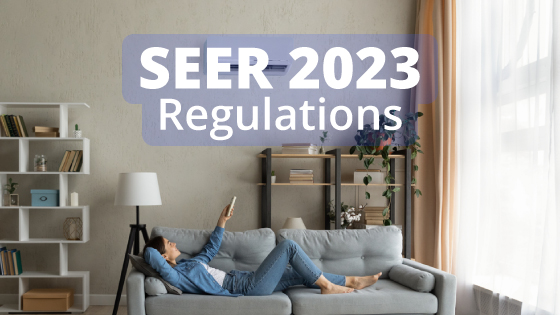Author: Jeff O'Hara
What Are the 2023 SEER Regulation Changes All About?
It’s already December, and you’re probably consumed with Holiday preparations, wrapping up presents along with those big year-end projects at work, and are more than ready to celebrate the incoming new year.
With all of that happening in your life, I’ll bet you aren’t aware of the new federally mandated SEER2 regulations that will go into effect in January 2023 that will directly affect the efficiency of new HVAC equipment. As usual, your priorities are all messed up, so once again, Nick’s Air Conditioning is here to fill you in on what you need to know about the updated requirements.
It’s not as bad as you think.
What is this SEER You Speak About? I’ve Never Heard of It.
Since most of you that are reading this aren’t HVAC technicians, you’re probably new to the concept of a SEER rating, why it exists, and what it means for your next HVAC system service or installation.
That’s OK. Many HVAC installers have to prepare themselves for the changes in a hurry, making sure they no longer stock –or worse, sell—outdated systems that do not meet the new requirements. Let’s find out together what these federally mandated changes mean for both of us.
What is the Big Change to the SEER Rating in 2023?
On January 1st, 2023, the minimum SEER rating on residential heating and air conditioning equipment is being raised by an entire point, from 13 to 14 (in the northern state) and 14 to 15 (in the southernmost states, including Texas). There’s nothing extraordinary about the increase, as the US Department of Energy (DOE) has been incrementally raising the SEER minimum since the program was implemented in 1992.
This time, the SEER rating system is undergoing a complete overhaul of how it tests heating and air conditioning equipment to reflect real-world conditions accurately. It’s even getting a new name and will be known from this day forth as SEER2. Whether or not this sequel does as well as “Top Gun II” remains to be seen. So far, the reviews we’ve seen of the SEER2 regulations say that it is better for the environment and, since it assures higher efficiency standards, is excellent news for your utility bills and comfort levels.
According to the DOE, the “cumulative consumer costs and savings over the next 30-year period will range from a conservative $2.5 billion to a more optimistic $12.2 billion” thanks to the new efficiency standards.
Here’s the Technical Stuff About the SEER Changes.
Currently (until December 31st, 2022), SEER ratings reflect the cooling output of a particular AC unit model during a cooling season, divided by the total electrical input for the same season. These tests are performed under lab conditions, measuring BTUs produced versus kilowatts burned, using a single presumed output of 58% of capacity.
The SEER2 rating is determined by using harsher test conditions that take more accurately into account things that reduce HVAC efficiency in our homes. HVAC systems can face several challenges once installed in our homes, from ductwork that either leaks at the seams or has been torn somewhere, to inadequate maintenance and excess ambient heat or cold in an attic or garage.
SEER2 tests apply up to 5 times more negative pressure to components like blower motors and compressors, which also helps to align the lab conditions with real-world conditions better. The tests also assume that HVAC systems, as they’ve become more powerful and efficient, no longer need to run around the clock like older systems and thus are tested at rapidly altered output power levels. The rating is based on how quickly –and efficiently—the room cools to the widely varying temperatures and how effectively it deals with humidity.
The 2023 SEER Regulation Changes Won’t Affect You, Yet.
New SEER regulations will only affect the average homeowner once it’s time to replace your HVAC system, where things promise to get interesting. At Nick’s Air Conditioning, we’re not trying to complain or lay our problems at your feet; after all, you’re the customer. But the folks most adversely impacted by the new SEER requirements are likely to be HVAC companies and, by extension, their technicians.
New regulations mean that existing products need to be re-engineered. These re-engineered products require parts, specifically silicon chips, of which an ongoing worldwide shortage affects every industry. Factor in the supply chain issues that have been occurring worldwide, and some smaller HVAC dealers could find themselves without the necessary stock to meet the new regulations.
Trust Nick’s AC – Your Houston Heating & Air Experts!
As a Trane® Comfort Specialist, Nick’s Air Conditioning is fully-stocked with SEER-15 rated furnaces and air conditioners, as well as mini-split heat pump systems from Mitsubishi Electric Trane®.
If your current HVAC system is living up to your family’s comfort needs and perhaps needs a little maintenance or a minor repair, Nick’s licensed and experienced HVAC technicians are standing by to help.
If saving money, preserving the environment for future generations, and enjoying optimum in-home comfort is essential to you and your family, give Nick’s Air Conditioning a call to see if it’s time to consider upgrading to a more efficient comfort system that is right for your home.


